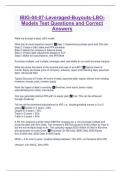IBIG-04-07-Leveraged-Buyouts-LBO-
Models Test Questions and Correct
Answers
Walk me through a basic LBO model
What are its most important levers? ✅Step 1: Determine purchase price and D/E ratio
Step 2: Create a S&U table and PPA schedule
Step 3: Adjust the company's balance sheet
Step 4: Project debt repayments based on FCF
Step 5: Make exit assumptions, find IRR/MoM
Purchase multiple, exit multiple, leverage used, and ability to cut costs/increase margins
What are some line items in the sources and uses of an LBO? ✅Typical Uses of
Funds: Equity purchase price of company, advisory, legal, and financing fees, assumed
debt, refinanced debt
Typical Sources of Funds: All forms of debt, assumed debt, equity rollover from existing
investors, excess cash, investor equity
Rank the types of debt in seniority ✅Revolver, term loans, senior notes,
subordinate/junior notes, mezzanine
Can you generate positive IRR with no equity gain ✅Yes. This can be achieved
through dividends
Tell me all the shorthand calculations for IRR, i.e.. doubling/tripling money in 3 or 5
years ✅Double in 3 years = 26%
Double in 5 years = 15%
Triple in 5 years = 25%
Triple in 3 years = 44%
A PE firm acquires a $100 million EBITDA company for a 10x purchase multiple and
funds the deal with 60% Debt. The company's EBITDA grows to $150 million by Year 5,
but the exit multiple drops to 9x. The company repays $250 million of Debt in this time
and generates no extra Cash. ✅Purchase: $1,000 total, $600 Debt, $400 Equity
Exit: $1350 total, $350 Debt, $1000 Equity.
MOIC = 2.5x over 5 years, roughly halfway between 15%-25%, so therefore 20% IRR
(Answer: 2.5x MOIC, 20% IRR)
, A PE firm acquires a $200 million EBITDA company using 50% Debt, at an EBITDA
purchase multiple of 6x. The company's EBITDA grows to $300 million by Year 3, and
the exit multiple stays the same. Assuming the company pays its interest and required
Debt principal but generates no additional Cash, what is the MINIMUM IRR?
How does the IRR change if the company repays ALL its Debt but nothing else
changes? ✅Purchase: $1,200 total, $600 Debt, $600 Equity
Exit: $1,800 total, $600 Debt, $1200 Equity
MOIC = 2x over 3 years, roughly 26% IRR
(Answer: 2x MOIC, 26% IRR)
Exit: $1800 Equity (since all debt is paid)
MOIC = 3x over 3 years, roughly 44% IRR
(Answer: 3x MOIC, 44% IRR)
A PE firm acquired Company A which had $100mm in EBITDA when it was bought. By
the end of 7 years, the company had 150mm EBITDA and was sold at a 10x multiple.
The transaction initially used $500mm in debt, there was $300mm in net debt at the
end, and the IRR of the deal was approximately 10%. What was the purchase multiple?
✅150mm EBITDA * 10x multiple = $1,500mm exit price
$1,500mm exit price - $300mm net debt = $1,200 exit equity
~10% IRR over 7 years, (Rule of 72, 72/10 = 7.2, so MoM ~2x)
Therefore, entry equity must be $1200/2 = $600
$600mm entry equity + $500mm initial debt = $1,100mm purchase price
$1,100 purchase price / $100mm EBITDA = 11x multiple
(Answer: 11x EBITDA multiple)
You have the option of either receiving $200M now or $40M each year for 5 years.
What IRR would you need to make the value of these two options equal? ✅Remember
that IRR makes all future cash flows equal 0 when discounted to the present value. If
any of the five future $40M payments are discounted, the sum of their present value
would be less than $200M. If any of the five future $40M payments are appreciated, the
sum of their present value would be greater than $200M. The only mathematical
possibility is if the IRR is 0.
What is the difference between CAGR and IRR? ✅In general, the IRR is a more
accurate measure of an investment's performance because it takes into account the
timing and size of all cash flows from the investment, as it is calculated by determining
the discount rate at which the net present value (NPV) of an investment is equal to zero
What is the formula for IRR? ✅Internal Rate of Return (IRR) = (Future Value ÷ Present
Value)^(1 ÷ Number of Periods) - 1




